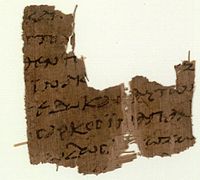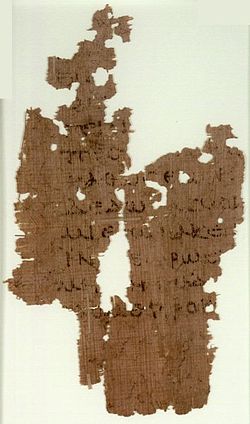John 17
| John 17 | |
|---|---|
 John 17:1-2 on Papyrus 107, written in 3rd century. | |
| Book | Gospel of John |
| Category | Gospel |
| Christian Bible part | New Testament |
| Order in the Christian part | 4 |
John 17 is the seventeenth chapter of the
- John 17:1–5: Jesus Prays for Himself
- John 17:6–19: Jesus Prays for His Disciples
- John 17:20–26: Jesus Prays for All Believers.[4]
The book containing this chapter is anonymous, but early Christian tradition uniformly affirmed that John composed this Gospel.[5]
Text

The original text was written in Koine Greek. This chapter is divided into 26 verses.
Textual witnesses
Some early manuscripts containing the text of this chapter are:
- Papyrus 108 (2nd/3rd century; extant verses 23–24)
- Papyrus 66 (~200; complete)
- Papyrus 107 (3rd century; extant verses 1–2,11)
- Codex Vaticanus (325-350)
- Codex Sinaiticus (330-360)
- Codex Bezae (~400)
- Codex Alexandrinus (400-440)
- Codex Ephraemi Rescriptus (~450; complete)
- Papyrus 84 (6th century; extant verses 3, 7–8)
- Papyrus 60 (~700; complete).
- Papyrus 59 (7th century; extant verses 24–26).
Old Testament references
Jesus' Prayer
Jesus refers to his Father six times in this chapter, calling God "Father" (Greek: πατηρ, pater), "Holy Father" (Greek: πατηρ ἅγιε, pater hagie, John 17:11) and "Righteous Father" (Greek: πατηρ δικαιε, pater dikaie, John 17:25). These are the only occurrences in the New Testament of the vocative forms αγιε and δικαιε, used in direct address to God.[7]
Verse 1
- Jesus spoke these words, lifted up His eyes to heaven, and said: "Father, the hour has come. Glorify Your Son, that Your Son also may glorify You".[8]
Alternatively, "After Jesus had spoken these words ..." (to his disciples, in chapter 16),[9] namely:
- "These things I have spoken to you, that in Me you may have peace. In the world you will have tribulation; but be of good cheer, I have overcome the world."[10]
Benson suggested that "these words" refers to "the words recorded in the three preceding chapters" (chapters 14 to 16).[3]
Verse 2
- "As You have given Him authority over all flesh, that He should give eternal life to as many as You have given Him.[11]
"Over all flesh" (σαρκός, sarkos), from the noun σὰρξ (sarx),
Verse 10
- All mine are yours, and yours are mine, and I am glorified in them.[14]
Jesus explains parenthetically,
Verse 11
- Now I am no longer in the world, but these are in the world, and I come to You. Holy Father, keep through Your name those whom You have given Me, that they may be one as We are.[17]
Swedish-based commentator René Kieffer distinguishes chapter 17 from the rest of Jesus' farewell discourse, referring to "a kind of timeless aspect" denoted by the words "I am no longer in the world".[2]
Verse 12
- While I was with them in the world, I kept them in Your name. Those whom You gave Me I have kept; and none of them is lost except the son of perdition, that the Scripture might be fulfilled.[18]
The words "in the world" are omitted by the most reliable early texts.[13] Judas' actions fulfill the words of Psalm 41:9:
- Even my close friend, someone I trusted, one who shared my bread, has turned against me.[13]
Verse 20
- I do not pray for these alone, but also for those who will believe in Me through their word.[19]
McEvilly divides Jesus' prayer into four parts: his prayers for himself (verses 1-5), for his disciples (verses 6-19), specifically for those who will come to faith through the teaching of the apostles (verse 20) and finally for the whole church (verses 21-26).[16]
Verse 21
- [T]hat they all may be one, as You, Father, are in Me, and I in You; that they also may be one in Us, that the world may believe that You sent Me.[20]
See also
- Farewell Discourse
- Jerusalem
- Jesus Christ
- That they all may be one
- Ut unum sint
- Related Bible parts: John 13, John 14, John 15, John 16
References
- Halley, Henry H.Halley's Bible Handbook: an Abbreviated Bible Commentary. 23rd edition. Zondervan Publishing House. 1962.
- ^ a b Kieffer, R., 59. John, in Barton, J. and Muddiman, J. (2001), The Oxford Bible Commentary Archived 2017-11-22 at the Wayback Machine, p. 990-1
- ^ a b Benson, J., Benson Commentary on John 17, accessed 6 June 2019
- ^ John 17:1–26: New King James Version
- ^ Holman Illustrated Bible Handbook. Holman Bible Publishers, Nashville, Tennessee. 2012.
- ^ "Biblical concordances of John 17 in the King James Bible".
- ^ Englishman's Concordance, ἅγιε and δίκαιε
- ^ John 17:1: New King James Version
- ^ John 17:1 NRSV
- ^ John 16:33: NKJV
- ^ John 17:2: NKJV
- ^ Englishman's Concordance, σὰρξ, accessed 29 November 2020
- ^ a b c Plummer, A. (1902), Cambridge Bible for Schools and Colleges on John 17, accessed 29 November 2020
- ^ John 17:10: English Standard Version
- ^ Cf. John Nelson Darby's translation at John 17:10
- ^ a b McEvilly, J. (1879), An Exposition Of The Gospels by The Most Rev. John Macevilly D.D.: John 17, accessed 8 February 2024
- ^ John 17:12: NKJV
- ^ John 17:12: NKJV
- ^ John 17:20: NKJV
- ^ John 17:21: NKJV
External links
- John 17 King James Bible - Wikisource
- English Translation with Parallel Latin Vulgate
- Online Bible at GospelHall.org (ESV, KJV, Darby, American Standard Version, Bible in Basic English)
- Multiple bible versions at Bible Gateway (NKJV, NIV, NRSV etc.)
| Preceded by John 16 |
Chapters of the Bible Gospel of John |
Succeeded by John 18 |
